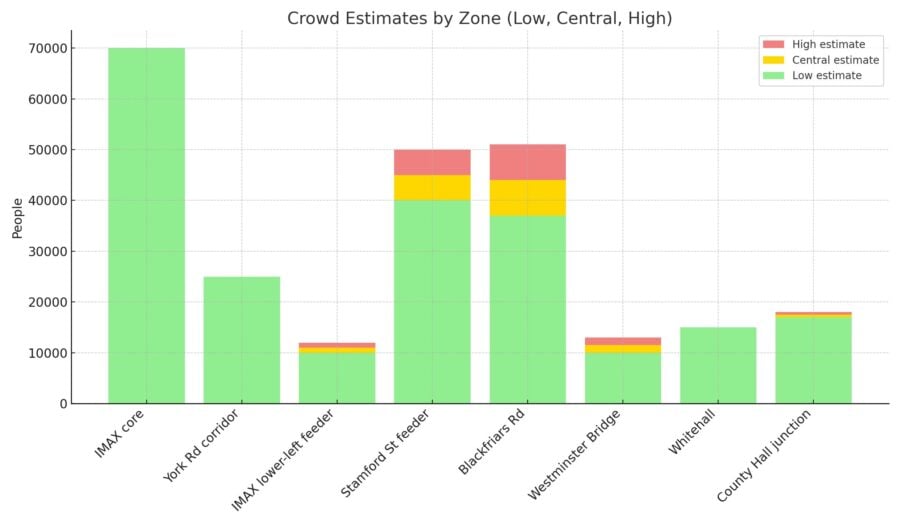The Unite the Kingdom Rally in central London drew wide attention, both for its size and for how it was reported.
Official crowd size estimates suggested about 110,000, yet aerial views indicated that this figure might reflect only the most concentrated core near the BFI IMAX theatre. This was confirmed with a single frame grab around the IMAX and the initial area up Stamford Road. To test this idea, we undertook an independent analysis using sequential aerial photographs.
The rally was organised by Tommy Robinson, (Stephen Yaxley-Lennon).
Some news outlets described it as a “far-right rally.” On the ground and in aerial images, however, it appeared measured, peaceful, and made up of men and women who looked like ordinary British citizens.
Police reported eight arrests and said they wished to speak with 16 others. Apart from a small number of incidents, the event was calm and orderly.
Why We Undertook This Crowd Size Analysis
Official estimates placed the crowd at about 110,000, but our analysis of aerial images suggested that figure represented only the core near the BFI IMAX. Our independent analysis was undertaken by snapshotting 19 sequential aerial photographs, aiming to provide a transparent, evidence-based estimate.
The Methodology
Still frames from aerial footage were calibrated against known landmarks, including the BFI IMAX (25.9 metres across), Westminster Bridge (26 metres wide), and feeder roads such as York Road, Stamford Street (A3200), Blackfriars Road, and Whitehall.
The rally was divided into zones:
-
IMAX core.
-
Feeder roads (York Rd, Stamford St, Blackfriars Rd).
-
Junctions (County Hall, Westminster Bridge, Whitehall).
Each zone was assessed separately to avoid double-counting. Crowd densities were applied according to recognised scales:
Most areas fell into the 2.5–3/m² range, reflecting slow-moving, shoulder-to-shoulder conditions.
Assumptions and Choices
-
Obstructions: Areas blocked by trees, roofs, or overhangs were excluded unless continuation was visible.
-
Sequential images: Because the helicopter moved over time, each frame was treated as unique.
-
Hidden flows: Where crowds disappeared under arches or buildings, only very short stretches were assumed to be occupied.
-
Unseen areas: Side streets and walkways not in the imagery were not included.
- Several Thousand may have been missed.
Crowd Estimate Summary
Aerial images of the London rally show a vast gathering spread across multiple corridors converging on the BFI IMAX theatre. Using known landmarks for scale, crowd densities were applied zone by zone to avoid double-counting.
-
BFI IMAX core: The most concentrated zone, with people packed shoulder-to-shoulder on surrounding streets, estimated at ~70,000.
-
York Road corridor: Southbound marchers feeding directly into the IMAX, about 25,000.
-
IMAX lower-left feeder: A smaller but solid group at the roundabout, 10,000–12,000.
-
Stamford Street (A3200): A continuous east–west corridor filled with marchers, 40,000–50,000.
-
Blackfriars Road: Both the Southwark Street junction and northward extension onto Blackfriars Bridge, 37,000–51,000.
-
Westminster Bridge: Crossing the Thames into Parliament Square, 10,000–13,000.
-
Whitehall: The government district north of Parliament, ~15,000.
-
County Hall junction: Crowds around the London Eye and County Hall, 17,000–18,000.

Taken together, the conservative estimate ranges from ~202,000 to ~228,000 people visible in non-overlapping sections. Central estimates place the total at around 215,000.
The dashboard shows how each feeder route contributed to the overall turnout, with the IMAX, Stamford Street, and Blackfriars Road accounting for the largest concentrations.

The Result
Adding together all zones gave an estimate of 202,000 to 228,000 people, with a central figure of about 215,000.
This is almost double the official estimate but well below claims of “millions.” The analysis shows the rally was far larger than some reports suggested, yet still peaceful and orderly.
Unite The Kingdom Rally Images


Five Key Caveats
-
Perspective distortion: Angled aerial shots may stretch or compress distances.
-
Obstructions: Trees and buildings obscure parts of the crowd.
-
Movement: Junction numbers fluctuated as groups merged.
-
Averages applied: Crowd density varied; weighted averages were used.
-
Coverage limits: Unphotographed side streets and underground areas were excluded.


